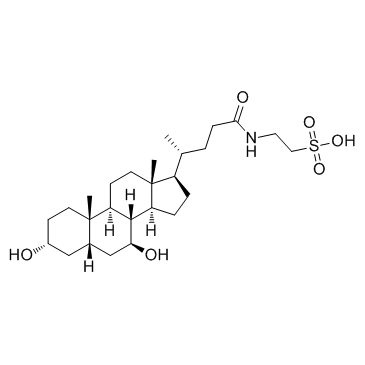Tauroursodeoxycholate (TUDCA) (Synonyms: 3α,7β-dihydroxy-5β-cholanoyl Taurine, TUDCA, UR-906) |
| Catalog No.GC34181 |
Tauroursodeoxycholate (TUDCA) (Tauroursodeoxycholic acid) is an endoplasmic reticulum (ER) stress inhibitor. Tauroursodeoxycholate (TUDCA) significantly reduces expression of apoptosis molecules, such as caspase-3 and caspase-12. Tauroursodeoxycholate (TUDCA) also inhibits ERK.
Products are for research use only. Not for human use. We do not sell to patients.

Cas No.: 14605-22-2
Sample solution is provided at 25 µL, 10mM.
Tauroursodeoxycholate (TUDCA) is a cytoprotective agent in a variety of cells including hepatocytes as well as an inducer of apoptosis in cancer cells[1]. Tauroursodeoxycholate, as an endoplasmic reticulum (ER) stress inhibitor, is effective in protecting the hepatocytes and restoring glucose homeostasis by reducing the endoplasmic reticulum stress[2].
In vitro, 200 µM TUDCA suppressed viability of hVSMCs (vascular smooth muscle cells) by inhibition of ERK (extracellular signal-regulated kinase) phosphorylation, through induction of MKP-1 (MAPK phosphatase-1) via PKCα (protein kinase Cα). And TUDCA inhibited both the proliferation and migration of PDGF-stimulated hVSMCs[1]. In vitro, 25 µM Tauroursodeoxycholate (TUDC) increases plasma membrane multidrug resistance-associated protein 2 (MRP2). And TUDC and cAMP increase Rab11 activity[3].
In vivo, TUDCA prevents the MPTP (1-methyl-4-phenyl-1,2,3,6-tetrahydropyridine)-dependent decrease of dopaminergic fibers and ATP levels, mitochondrial dysfunction and neuroinflammation. TUDCA administration (50 mg/kg), the mice also displayed reduction in foot dragging and an overall improvement in gait[4]. Mice were treated with TUDCA 0.5 mg/g every 3 days, for a total of 7 injections, which showed an increase in neuromuscular junction innervation in the mutated mice[5]. TUDCA treatment (100 mg, 3 times/day) also reduces neurological impairment in rats with acute cerebral infarction[6].
Kim SY, et al. Tauroursodeoxycholate (TUDCA) inhibits neointimal hyperplasia by suppression of ERK via PKCα-mediated MKP-1 induction. Cardiovasc Res. 2011 Nov 1;92(2):307-16.
Kim SY, et al. Tauroursodeoxycholate (TUDCA) inhibits neointimal hyperplasia by suppression of ERK via PKCα-mediated MKP-1 induction. Cardiovasc Res. 2011 Nov 1;92(2):307-16.
Park SW, et al. Rab11, but not Rab4, facilitates cyclic AMP- and tauroursodeoxycholate-induced MRP2 translocation to the plasma membrane. Am J Physiol Gastrointest Liver Physiol. 2014 Oct 15;307(8):G863-70.
[3] Rosa AI, et al. Tauroursodeoxycholic acid improves motor symptoms in a mouse model of Parkinson's disease. Mol Neurobiol. 2018;55(12):9139-9155.
[4] Thams S, et al. A stem cell-based screening platform identifies compounds that desensitize motor neurons to endoplasmic reticulum stress. Mol Ther. 2019;27(1):87-101.
[5] Bian KY, et al. DCA can improve the ACI-induced neurological impairment through negative regulation of Nrf2 signaling pathway. Eur Rev Med Pharmacol Sci. 2019;23(1):343-351.
References:
Average Rating: 5 (Based on Reviews and 19 reference(s) in Google Scholar.)
GLPBIO products are for RESEARCH USE ONLY. Please make sure your review or question is research based.
Required fields are marked with *




















